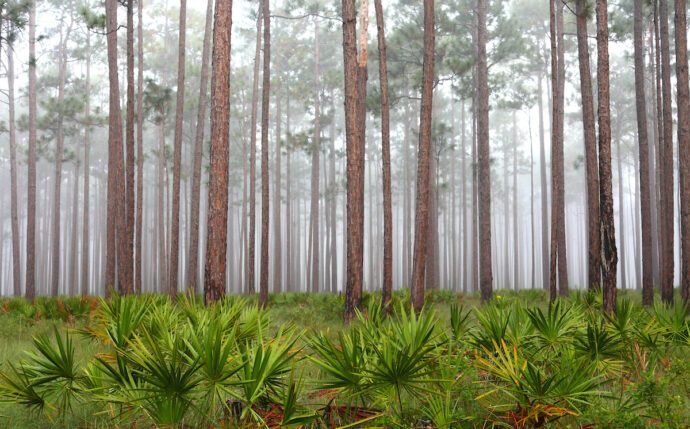
Insights from the building of the Northwest Florida Sentinel Landscape Partnership
Kent Wimmer, Coordinator of the Northwest Florida Sentinel Landscape, and Senior Northwest Florida Representative for Defenders of WildlifeThis is the first of two articles that seek to capture insights and lessons learned from the emergence of the Northwest Florida Sentinel Landscape. This first piece highlights the key factors and successes that allowed agencies and non-governmental organizations to come together to build a broad coalition of partners—and sustain that coalition through the onset of the pandemic—to successfully realize the designation of this new Sentinel Landscape. A future article will explore insights from how this partnership is collaborating to achieve its landscape conservation goals.
The state of Florida has promoted landscape conservation since the mid-1990’s when the first statewide greenway vision and plan were adopted, calling for connecting hubs of conserved land with greenway connectors through working lands. In the early 2000’s, Deborah Keller of the Florida Chapter of The Nature Conservancy envisioned the Northwest Florida Greenway to inspire agencies and organizations to work together to conserve land while protecting military missions. Florida Governor Jeb Bush and his cabinet, and the Department of Defense signed the Northwest Florida Greenway Memorandum of Partnership in 2003. A memorandum of agreement executed in 2004 by federal and state agencies outlined their roles and responsibilities for supporting the Northwest Florida Greenway.
Indeed the Northwest Florida Greenway was one of the inspirations for the current Sentinel Landscapes program, which formed in 2013 when a coalition of federal agencies, state and local governments, and non-governmental organizations came together to collaborate with private landowners “to strengthen military readiness, conserve natural resources, bolster agricultural and forestry economies, and increase climate change resilience.” Leading the Sentinel Landscapes Partnership is the Federal Coordinating Committee (FCC) whose agencies include the U.S. departments of Defense (Readiness and Environmental Protection Integration (REPI) Program), Agriculture (Natural Resources Conservation Service and Forest Service) and Interior (Fish and Wildlife Service).
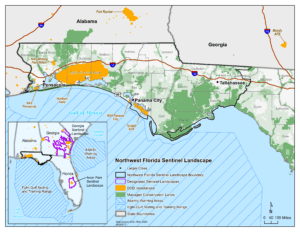
The Northwest Florida Sentinel Landscape was designated in early 2022, following a four-year coalition building process. Map courtesy of Defenders of Wildlife on behalf of the partners of the Northwest Florida Sentinel Landscape.
By 2017, seven Sentinel Landscapes had been designated across the nation. In each landscape, partners were working to maintain the essential missions of military installations by avoiding encroachment of incompatible land uses and by promoting forestry and agricultural production, natural resource conservation, coastal resiliency, and sustainability.
As an early inspiration for the Sentinel Landscapes program, partners in Northwest Florida began to coalesce around an effort to formally designate the Northwest Florida landscape in 2017. From those early exploratory conversations the process took longer than we anticipated, but in early 2022 the Northwest Florida Sentinel Landscape was designated. This article reflects on the process of building a coalition in support of designation, and offers key insights and observations on successfully advancing collaborative landscape conservation efforts.
INSIGHT: The importance of dedicated and sustained organizational leadership. As it became clear that there was interest in advancing a Northwest Florida Sentinel Landscapes proposal, the obvious organization to play the key leadership role in building a coalition of supporting partners was the Florida Chapter of The Nature Conservancy (TNC), given its history with the Northwest Florida Greenway partnership 13 years prior. However, TNC Florida had already led the successful designation of the Avon Park Air Force Range Sentinel Landscape in 2016 and could not commit to leading another partnership seeking Sentinel Landscape designation. Fortunately, Defenders of Wildlife was positioned to take this leadership role through its existing staff presence who was already actively advocating for landscape and habitat conservation in the region, and had been seeking an opportunity to engage in a Sentinel Landscape.

The Apalachicola National Forest is located just outside Tallahassee in Northwest Florida. Photo by Randy Traynor
At the invitation of the U.S. Air Force and with the blessing of The Nature Conservancy, Defenders accepted the responsibility to build support for a partnership to seek Sentinel Landscape designation for Northwest Florida in 2017. Defenders’ consistent leadership over four years, anticipating a designation cycle to open each year, enabled a broad coalition of partners to be standing behind the Northwest Florida designation when the Sentinel Landscapes Federal Coordinating Committee opened the designation cycle in January 2021. To maintain momentum, Defenders devoted considerable staff time to building our partners list, meeting with prospective partners to introduce the Sentinel Landscape concept, refining the focus for our partnership and Sentinel Landscape boundary, creating a factsheet, and developing a web map application and story map to tell our story and display our partners’ priorities.
INSIGHT: The importance of articulating a “bigger picture” for partners. The prospects of Sentinel Landscape designation offered a focusing element on which to build collaboration. Recruiting partner support was straightforward because Sentinel Landscape designation provides its partners with greater access to funding, financial incentives and assistance from federal, state and local government, as well as private sector programs to accomplish their existing goals. As we waited from 2017 through 2020 for the next Sentinel Landscape designation cycle to open, we looked for opportunities to introduce the Sentinel Landscape concept at meetings attended by our prospective partners including the Southeast Regional Partnership for Planning and Sustainability, the Florida Defense Support Task Force, Florida Defense Alliance, and Northwest Florida Base-Community Working Group.
We also sought to underscore how a Northwest Florida Sentinel Landscape would fit into broader regional efforts. We connected with the Strategic Conservation Assessment of Gulf Coast Landscapes, which featured the Northwest Florida Sentinel Landscape as a Use Case Study for identifying datasets and using its Geographic Information System mapping tools to identify and evaluate areas for conservation projects. We also enjoyed significant contributions of data, mapping, and writing support for our proposal from the U.S. Fish and Wildlife Service’s Florida Ecological Services Field Office, the Southeast Conservation Adaptation Strategy, the Southeast and South Atlantic Conservation Blueprint teams, the Florida Natural Areas Inventory, and the University of Florida GeoPlan Center. In addition, we identified and mapped our partners’ priority focus areas and projects, including the Florida Wildlife Corridor which connects conservation lands and habitats the length of Florida.
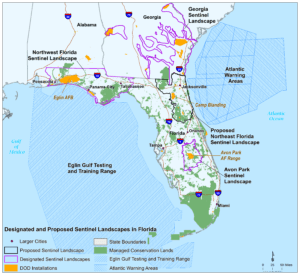
The Northwest Florida Sentinel Landscape is one of three designated or proposed Sentinel Landscapes in Florida–with a four just across the state line in Georgia. Map courtesy of Defenders of Wildlife on behalf of the partners of the Northwest Florida Sentinel Landscape.
Knowing Florida not only already had an existing Sentinel Landscape—Avon Park Air Force Range Sentinel Landscape—but also had another landscape—Northeast Florida—that was simultaneously pursuing designation, we spent time connecting with partners to explore and articulate how all these initiatives could coordinate and complement one another. These conversations culminated in January of 2022 with 25 parties representing federal, state and regional agencies, and non-governmental organizations (NGOs) supporting these three landscapes executing the Sentinel Landscapes in Florida Memorandum of Understanding. This MOU provides an organized framework for federal and state agencies and NGOs to strengthen collaboration and streamline activities that connect private landowners around military installations with voluntary government assistance programs in Florida. Our MOU complements existing Florida legislation and programs to support and protect military installations throughout the state and is another model for statewide coordination that other Sentinel Landscapes and states may consider.
Sentinel Landscapes are bringing together partners who value the opportunity of achieving more significant conservation results through collaboration rather than by pursuing actions and projects they can achieve independently. This foresight is being realized through the many collaborative proposals to federal and state funding programs which are seeking large-scale, multiple agency/partners coordinated projects and programs rather than many small-scale projects and partnerships. The Sentinel Landscape designation fosters coordination and can help proposals within Sentinel Landscapes be more competitive and successful in securing funding. By establishing a collective vision for the NWFSL, our partners can see how their organizations’ efforts fit into and complement regional priorities for conserving habitats, retaining working lands, and protecting military missions.
INSIGHT: The importance of investing in relationships. As noted above, Defenders was committed to providing coordination support in building a broad coalition that could support the designation and work collectively to advance the broader vision. Having a dedicated coordination role staffed within the landscape was essential for allowing us to invest time in building and sustaining relationships amongst partners. This proved especially helpful as we navigated the pandemic and as the next Sentinel Landscapes nomination window was continually delayed.
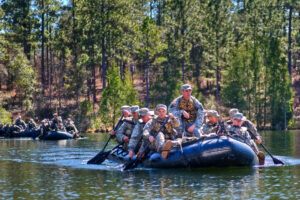
U.S. Army Ranger students paddle in rubber boats across a lake during the swamp training phase at Camp Rudder on Eglin Air Force Base. DoD photo by John D. Helms, U.S. Army.
This relationship-building started early: From 2017 to 2019, as we annually anticipated the opening of a Sentinel Landscape designation cycle, we developed relationships with potential partners through personal meetings with federal and state agency staff and other NGOs. We discussed how a Sentinel Landscape designation may aid in accomplishing their missions, and how they may contribute to ensure success of our partnership.
During the summer of 2019 we invested in individual one-on-one conversations with prospective partners to seek their support and discuss how their agency or organization might be able to contribute to making our NWFSL partnership successful. We held our first in-person collective meeting in September 2019 to provide our potential partners a forum to learn more about our proposal and what was expected of our partners, to provide feedback and to personally hear what others thought. To aid participation, we held a morning gathering in conjunction with a statewide meeting that many of our partners would otherwise be attending. When COVID eliminated the opportunities for face-to-face meetings in 2020 and the designation cycle was postponed again, we recruited representatives from the principal state and federal agencies and NGOs to serve on a steering committee and hosted virtual meetings beginning in the summer of 2020. The steering committee allowed individual organizational interests to coalesce into our collective vision for the NWFSL, determined our focus areas, goals and objectives. Through our steering committee we developed and submitted our pre- and full proposals seeking designation and executed the Florida Sentinel Landscapes Memorandum of Understanding described above.
* * * *
The designation of the Northwest Florida Sentinel Landscape in February 2022 was the result of the deep commitment of both individual and organizational partners throughout the landscape that had developed over the last five-plus years, thanks in part to the three factors identified above. Because of the dedicated support by the state of Florida and other partners, Florida is the first state with two federally-designated Sentinel Landscapes – the Avon Park Air Force Range and Northwest Florida. In addition, a third Sentinel Landscape has been proposed in Northeast Florida by the North Florida Land Trust and partners. With the privilege of a full-time coordinator, Northwest Florida is developing a more cohesive and effective landscape partnership and conservation delivery network by helping our partners better understanding where priorities overlap, and the status of several projects being pursued by numerous entities. In a subsequent follow-up piece, we will explore the insights that are emerging as the NWFSL continues to guide collaboration in the region to achieve landscape conservation successes in Northwest Florida.
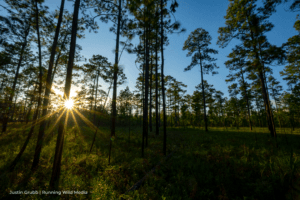
The sun sets through a longleaf pine stand in Northwest Florida. Photo by Justin Grubb. Running Wild Media
For more information on the Northwest Florida Sentinel Landscape, visit our webpage, or contact Kent Wimmer or David Wolfe. For more information on the Sentinel Landscape program, visit the program’s website or watch this video. Founded in 1947, Defenders of Wildlife is a national non-profit conservation organization focused solely on wildlife and habitat conservation and the safeguarding of biodiversity. For more information, please visit Defenders’ website. Photo credit of featured photo at the top of the article: Longleaf pine and palmetto forest in the Apalachicola National Forest; Photo by Julie Tew courtesy of Defenders of Wildlife.
